Poland and Volhynia: Tribute to Victims or Self-Victimization?
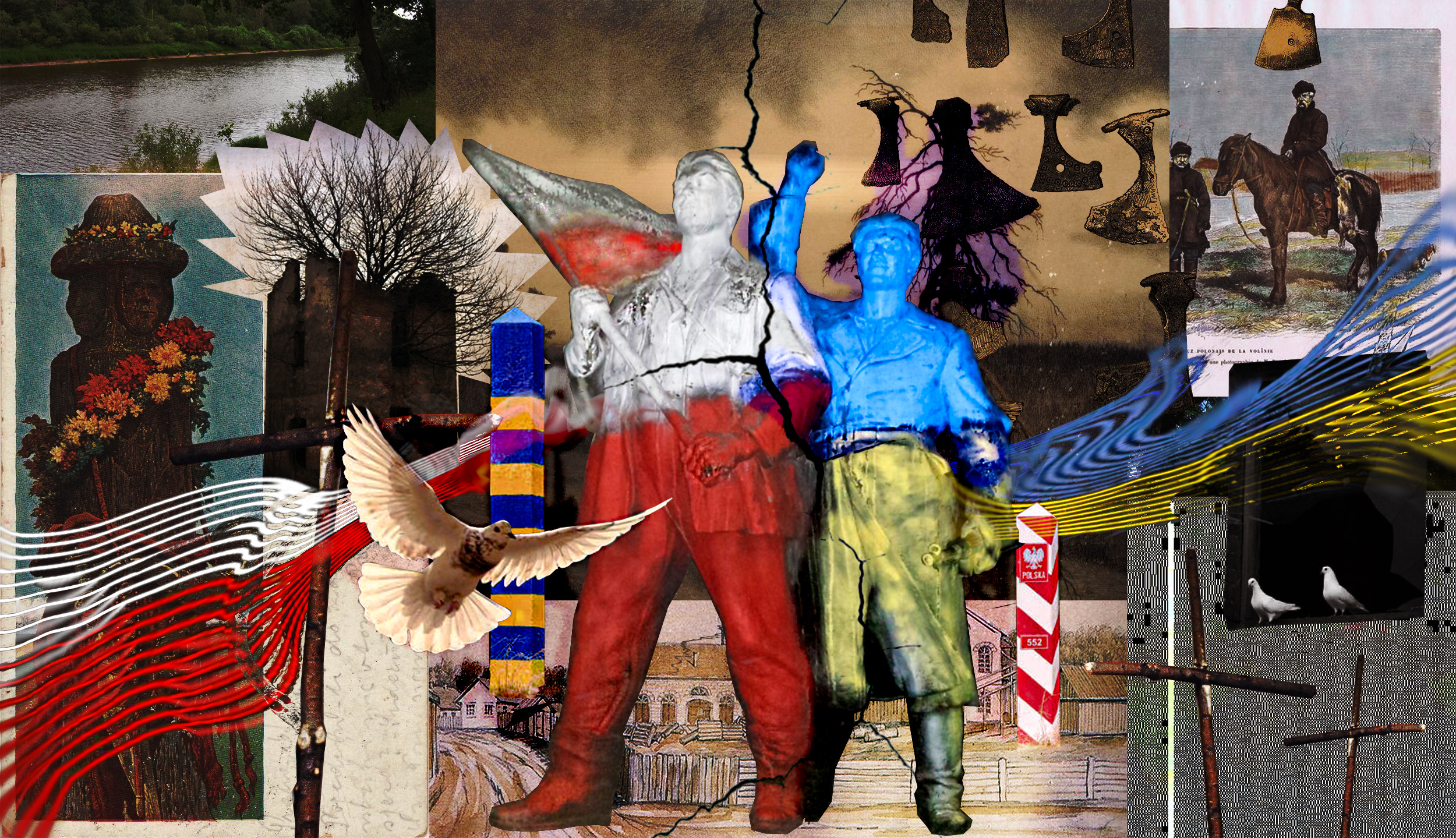
How does the Polish far right instrumentalize the Volhynian massacres of 1943–1944? Can one pursue historical justice without impeding the Polish-Ukrainian alliance? Andrea Braschayko (Italy), Francesco Brusa (Italy), and Szymon Martys (Poland) report on their weekend at the commemoration ceremony in Volhynia
From the vantage point of the road below, the Chełm Cathedral, located in eastern Poland, exerts a commanding presence over the city while simultaneously withdrawing into the background. Its immaculate white façade and side walls stand tall in a striking contrast to the surrounding monastery walls, which enclose the structure on all sides. On the early evening of a particularly gloomy July 11, the area in front of the church resembles a place-of-arms [editor’s note: any place in a fortification where troops can gather]. Alongside those who had gathered to pray, groups of uniformed boys and girls assembled from all sides, forming orderly ranks. A number of worshippers are seen brandishing white-and-red Polish flags, and their faces display a mixture of contrition and pride. At the same time, two black cars, parked slightly off to one side, serve as a testament to the presence of Karol Nawrocki, the newly elected president of the country, who is also in attendance.
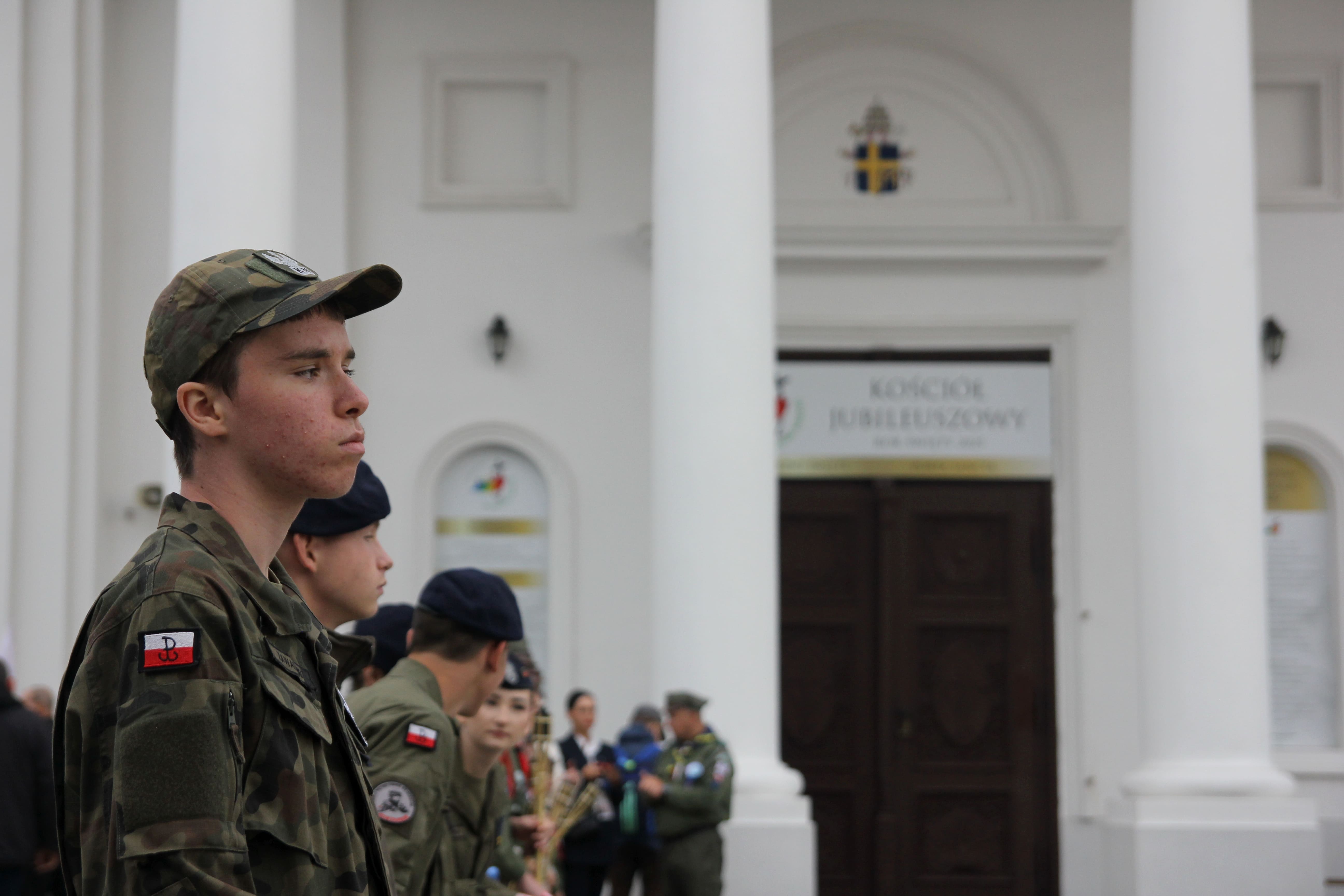
“The Ukrainians had the right to fight for their own state, but they did not have the right to murder innocent people,” the priest says from the altar. The service under consideration carries only a partly religious meaning. For a while now, the 11th of July has been the national day of remembrance in Poland for the victims of the Volhynian massacres, which took place between spring 1943 and summer 1944.
Between 50,000 and 200,000 people of Polish (and Jewish) origin were killed by the Ukrainian nationalist groups of the OUN-UPA [editor’s note: UPA stands for the Ukrainian Insurgent Army, which was founded by the Organization of Ukrainian Nationalists (OUN) on October 14, 1942]. This was a consequence of an ethnic cleansing campaign that took place in territories that, prior to World War II, had been under Warsaw’s control and subsequently became part of Soviet Ukraine. This brutal campaign represented the culmination of already strained, far from idyllic, relations between the two communities. These tensions initially manifested violently during the 1920s and 1930s, when the substantial Ukrainian minority — accounting for approximately 15% of the nearly 30-million population within the recently established Second Polish Republic — was forced to coexist under assimilation policies. This situation gave rise to long-standing rivalries and divisions that had first developed during the period of Austro-Hungarian rule.
According to the 1931 census, the city of Chełm was predominantly inhabited by Jews and Poles, with a small population of Ukrainians numbering approximately 5,000 people and thus constituting roughly one sixth of the total population of the city. However, within the broader county (i.e., powiat), the Ukrainian population was significantly larger, numbering over 150,000 individuals, which represented more than 60% of the total population.*
In essence, Chełm Cathedral serves as a symbol of the complex divisions and historical legacies present in the region. The current edifice has been constructed on the site of what was once an Orthodox center of worship, thereby serving as a testament to the historical presence of the Ukrainian population in the area. As dusk descends, the church doors are finally opened, and divisions of the army and armed forces begin a grand parade, moving towards the municipal museum dedicated to the Volhynia massacres. It is the only museum of its kind in the country; however, it is still not operational, despite the project’s long-standing existence. At one point, government funding was withdrawn, which left the Chełm authorities unable to complete the structure.
At that moment, President Nawrocki intervenes, stating: “Poles have the right to remember the Volhynia genocide regardless of changing times and circumstances. And we will remember.” He adds, “I appeal to the President of Ukraine to allow full-scale (!) exhumations in Volhynia.” Ukraine’s ambassador, Vasyl Bodnar, who is also present at the ceremony, replies: “We must talk openly about this history. We must call a crime a crime. We must apologise, and I apologise. Today, Ukraine is fighting not only for its freedom, but also for our common freedom. But the past must be explained honestly.”
Diplomatic Tensions over a Historical Quarrel
The fact that a Polish and a Ukrainian representative stood together at such a commemoration cannot be taken for granted. The issue of the Volhynia massacres has recently returned to the fore both nationally and internationally, after years of relative silence and marginal attention.
In early 2025, the Ukrainian government lifted a long-standing de facto ban on exhumations by granting Polish teams the permission to resume the recovery of remains from mass grave sites. The decision, which was publicly endorsed by Polish Prime Minister Donald Tusk and Culture Minister Hanna Wróblewska, was seen as a long-anticipated step forward in Polish-Ukrainian historical reconciliation.
It is important to note that the issue of Volhynia does not align with traditional political divisions in Poland. It would be overly simplistic to characterize the situation as a conflict between conservatives, who advocate for historical justice at any cost, and liberals, who prioritize reconciliation. On the one hand, for instance, in 2024, Defense Minister and Deputy Prime Minister Władysław Kosiniak-Kamysz, leader of the conservative Polish People’s Party (PSL), which is allied with Donald Tusk’s Civic Coalition, stated that Ukraine should not be allowed to join the EU until the historical issue of the massacres of Poles in Volhynia is resolved.
On the other hand, however, his remarks were contradicted by Polish President Andrzej Duda, a member of another conservative party, Law and Justice (i.e., Prawo i Sprawiedliwość, or PiS). He declared: “If someone says in this regard that they are going to block Ukraine's access to the European Union, they are following Vladimir Putin’s policy. I don’t know if this is the intention of those who are now in power.” Duda’s intervention likely also served to intensify the political clash with the Tusk government.
Yaroslav Hrytsak, the Director of the Institute of Historical Studies (IHS) at the Ivan Franko National University of Lviv and a renowned Ukrainian historian, has noted that even in the absence of political changes in Poland, there have been escalatory and reconciliatory dynamics — particularly in the relations between Zelensky and the Tusk government.
“I witnessed a sharp altercation between Zelensky and [Polish Foreign Minister] Radosław Sikorski on Volhynia in September of last year — they were literally shouting at each other,” Hrytsak recalls. “But afterwards, both sides reached a consensus that the conflict must be addressed, and as soon as possible. I believe a crucial role was played by Ukraine’s new Foreign Minister, Andrii Sybiha: he is a highly skilled diplomat, he knows Poland very well, and he understands the complexities of Polish-Ukrainian relations,” he added.
The first exhumations took place in April in the former Polish village of Puzhnyky, now part of western Ukraine. These exhumations were carried out with the participation of both Polish and Ukrainian specialists, as well as relatives of the victims. In the days that followed, the two governments agreed to expand the work to include new sites in Ukraine’s Lviv region and a village just across the border in Poland.
This renewed process has brought long-awaited recognition to the victims’ families and returned the memory of Volhynia to the forefront of bilateral diplomacy. However, this opening was soon strained by the relentless focus on the massacres during the election campaign of Karol Nawrocki. Nawrocki, who was elected with the Law and Justice party and who had formerly presided over the Polish Institute of National Remembrance (IPN), has placed the issue at the core of his political agenda.
A mere few weeks later, a reshuffling of the leadership at Ukraine’s Institute of National Remembrance (UINR) occurred, a maneuver that bore resemblance to a tit-for-tat between the two institutions (that is, the IPN and the UINR), which, as Ukrainian historian Georgiy Kasianov has observed, represent “not so much the two countries themselves,” but rather their more nationalist sectors, “like the diaspora.”
As a result, the position previously held by Anton Drobovych, a proponent of liberal ideology, was assumed by the nationalist historian Oleksandr Alfyorov. Alfyorov, a history professor, has recently participated in combat operations alongside the Third Assault Brigade, a unit within the Ukrainian Armed Forces under the command of Andrii Biletskyi, the founder of the prominent far-right paramilitary group known as “Azov.”
This development signaled an intensification of the rift between the two memory institutes. This occurred in the wake of a brief period of ostensible reconciliation at the highest levels of government — in particular, between Donald Tusk and Volodymyr Zelensky.
However, on July 13, two days after the Chelm commemoration, Polish President Andrzej Duda and his Ukrainian counterpart Volodymyr Zelensky attended an ecumenical memorial mass in Lutsk Cathedral, located approximately 50 kilometers from the Polish border in northwestern Ukraine. In a previous statement, Duda had quoted Zelensky as saying: “Andrzej, I had never heard about the killings, about the murders of Poles in Western Ukraine, in Volhynia. We weren’t taught this in school.”
This remark was quickly seized upon by Russian propaganda, which began circulating unfounded claims that Zelensky’s history teacher in Kryvyi Rih was a far-right man from Lviv and a devoted admirer of the OUN-UPA.
Domostawa, the Festival of Resentment of the Polish Far-Right
In Poland, however, the Volhynian massacres are being commemorated in a variety of settings beyond official events. In fact, less than twenty-four hours after the Chełm ceremony, and fewer than a hundred kilometers away, another “commemoration” expressed a far less conciliatory viewpoint. Last year, the village of Domostawa made headlines when, unlike many other communities in the region, it agreed to host a monument to the Volhynia massacres. The monument’s design is noteworthy for its stark appearance, featuring a colossal eagle with a grim expression, serving as a symbol of the Polish nation. Etched into the eagle’s body is a cross, meticulously designed and crafted. The cross, in turn, contains a Ukrainian trident piercing the small body of an infant — a symbol that leaves little to the imagination.
People arrive by car, motorbike and even coach from across the region — some of these visitors are from the capital city of Warsaw, while others are from more distant parts of the country. The road adjacent to the forested area where the monument is located is transformed into a temporary car park. Those who have gathered for this decidedly non-sacred pilgrimage assemble into groups and clusters. Some might even be tempted to call them true militias, representing a “Babylon” of far-right nationalist, xenophobic, anti-Ukrainian, and anti-Semitic movements: Rodacy Kamraci (i.e., a far-right Polish political party known for its overly pro-Russian stance), Wataha Głosu Obywatelskie, Ruch Bronimy Polskiej Granicy (i.e., the Border Defence Movement), and other smaller groups. Some hold placards denouncing the OUN-UPA and Stepan Bandera; others, adopting a pseudo-pacifist stance, ask whether Poles too will soon be dragged into war by Ukraine. Some participants dress in the style of nationalist militias from the 1920s and 1930s, while others have their children pose beside Celtic crosses. Some individuals have chosen to wear hats emblazoned with the Trump logo.
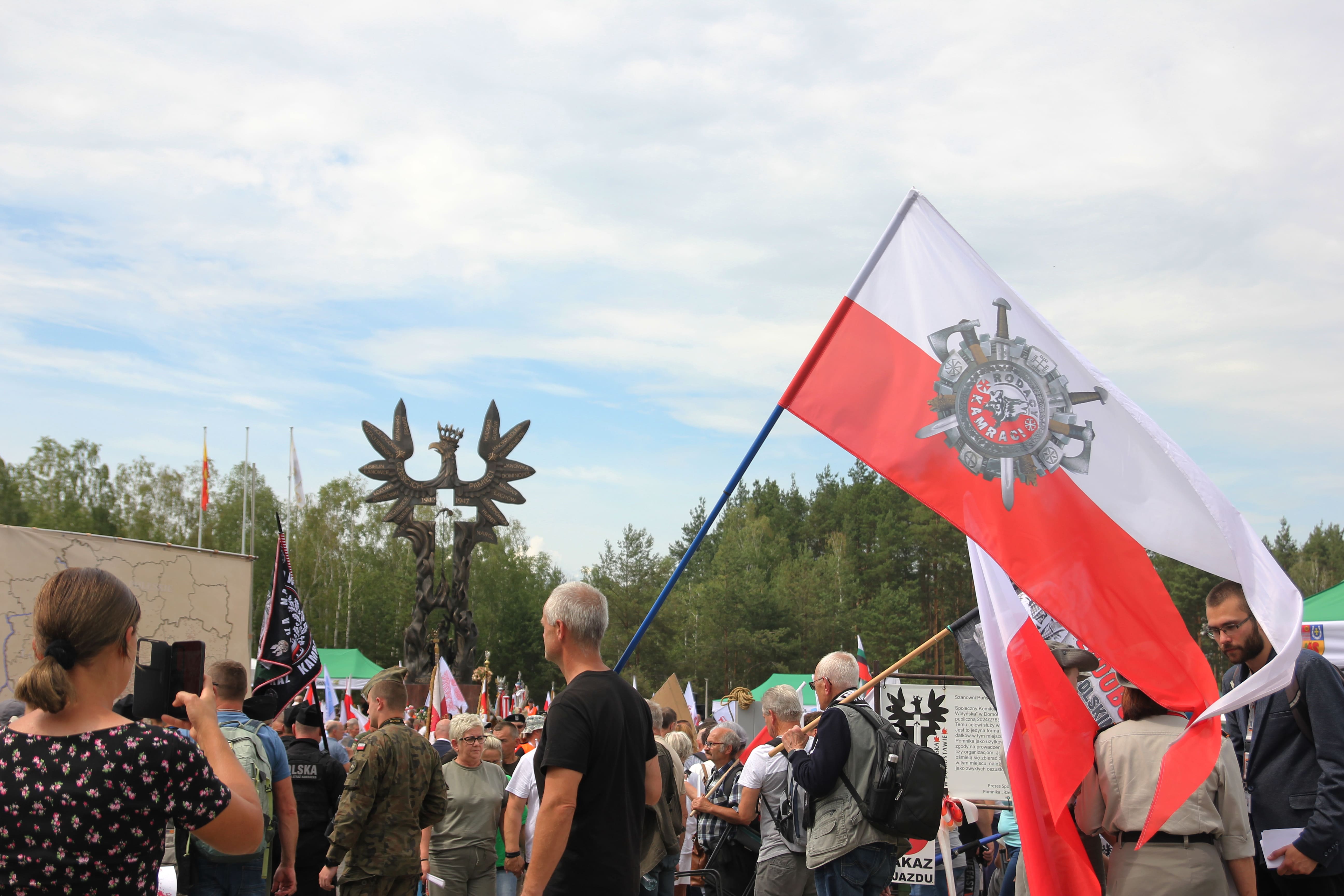
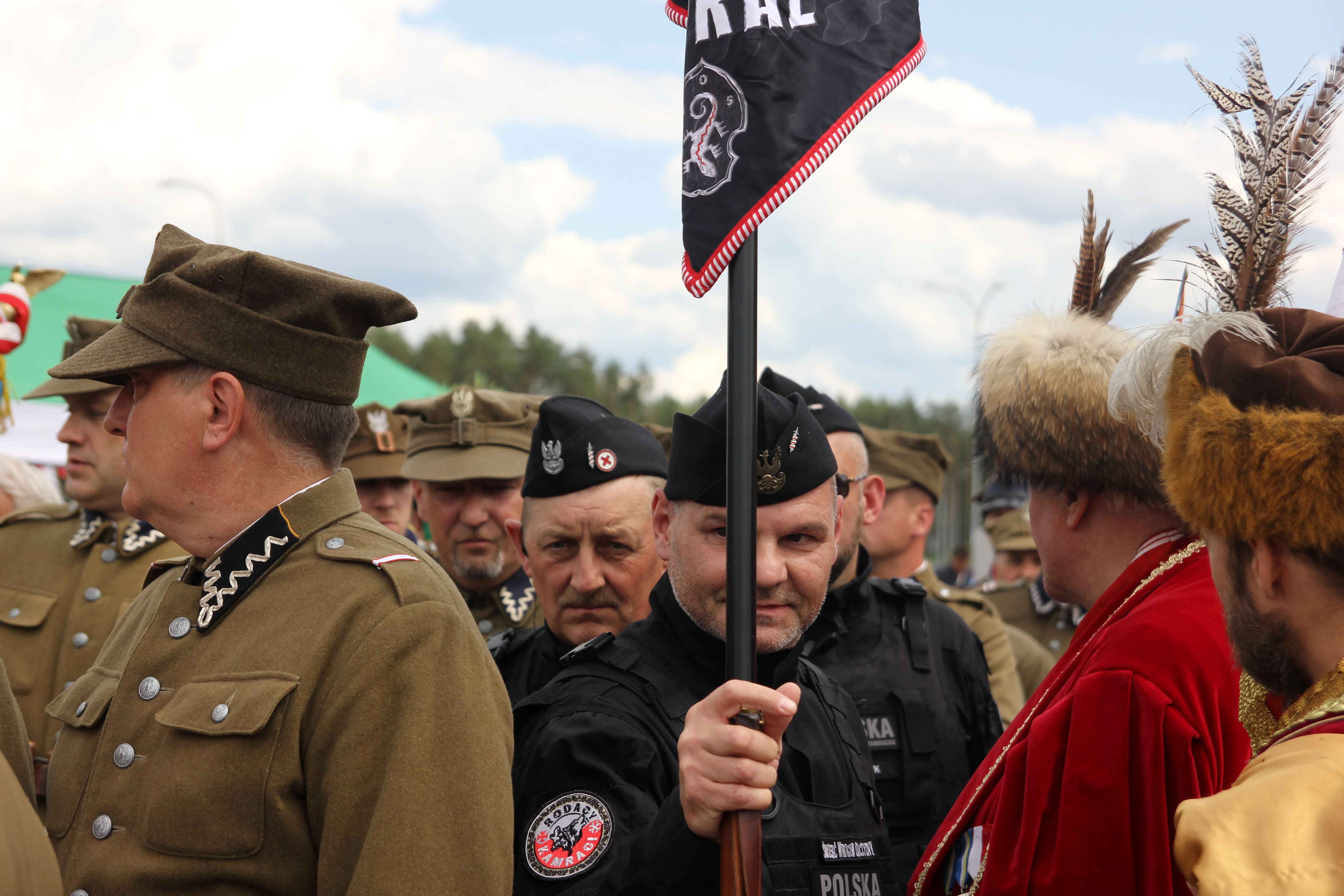
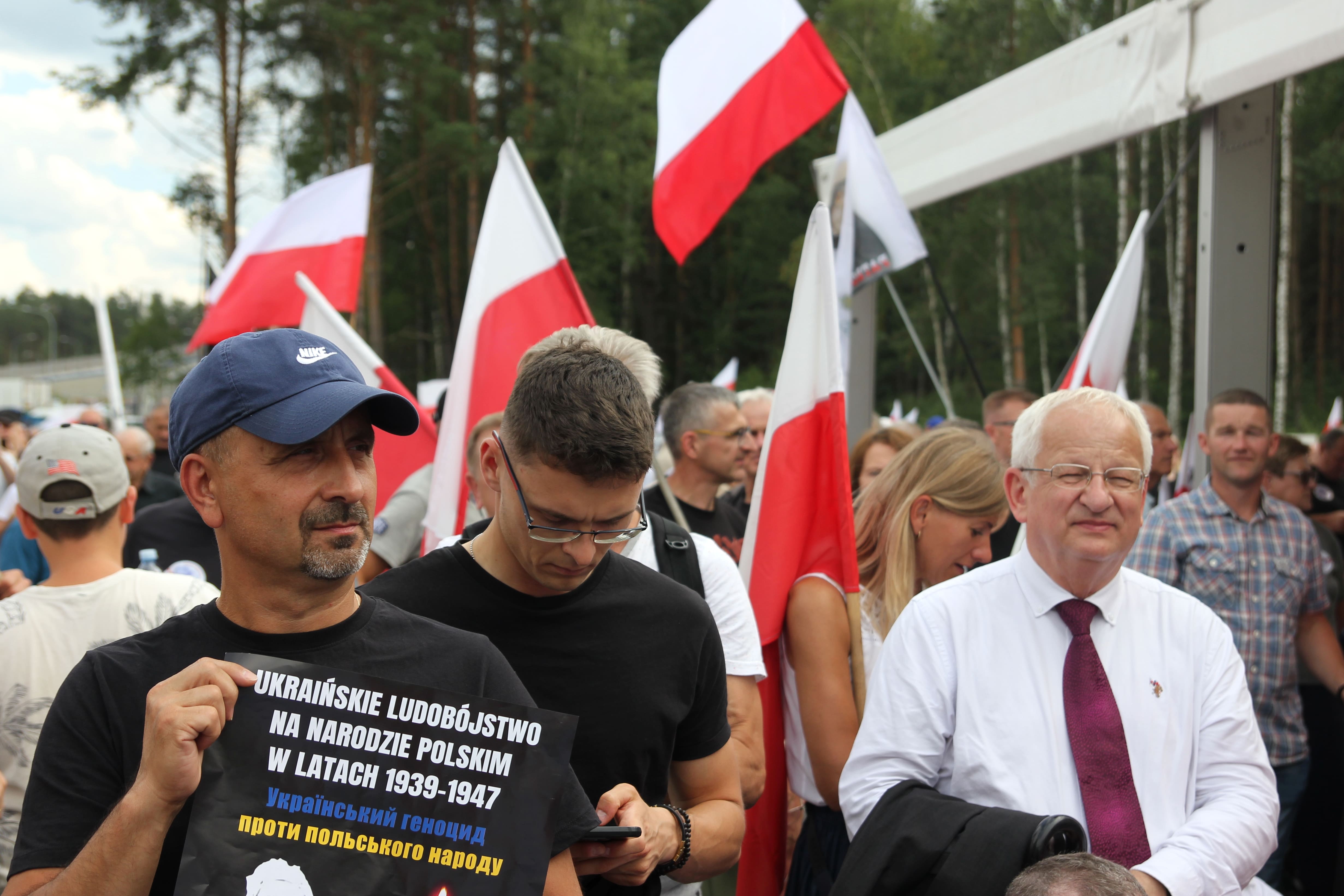
“Also two months after the beginning of the Russian invasion (when we published one of our reports on the topic) we noticed that the Polish extreme right was exploiting the Volhynia massacre for political and propaganda purposes and to stir up hatred against refugees from Ukraine,” comments Łukasz Jakubowski, a member of the association Never Again, the Polish Anti-Racist Association. Founded in 1996, it has organized numerous campaigns, including ‘Music Against Racism’ and ‘Let's Kick Racism Out of Stadiums.’ It also monitors racist and xenophobic crimes and incidents, as well as acts of discrimination in Poland. The organization’s activities are documented in a publication entitled ‘Brunatna Księga’ (translated as The Brown Book). Jakubowski adds, “The aim of the propaganda was, of course, to discourage Poles from helping refugees at the Polish-Ukrainian border and then, after one year, we observed numerous instances in which the Volhynia issue was used to spread hatred. Through Youtube channels and online posts, the far right combines conspiracy theories with anti-Ukrainian hate, propaganda straight out of Putin’s Russia, and a desire for revenge for past events. Far-right politicians and related circles have been exploiting this topic politically for many years.”
According to Jakubowski, the event in Domostawa was not, in fact, about the massacres in Volhynia. That is to say that many influential figures, including prominent nationalist historian Lucyna Kulińska and controversial European MP Grzegorz Braun, who is known for his far-right views, strategically utilized the event to advance their anti-migrant and pro-sovereignistic agendas. For instance, Kulińska stated: “We are a nation that is practically bankrupt, yet we support millions and pay money to foreigners. How many of these people have grandparents who murdered our children? How many hang Polish flags today, without our services investigating this, how many live here in Poland with the papers of murdered victims? And we wonder why they are anti-Polish.”
Many politicians associated with Konfederacja in the past [editor’s note: a monarchist ultra-nationalist party] were in attendance, including Andrzej Zapałowski, Janusz Korwin-Mikke, Włodzimierz Skalik, and Roman Fritz. Other notable attendees included representatives from the PiS party, such as Przemysław Czarnek and Dariusz Matecki. According to Jakubowski, “It is not surprising that the 82nd anniversary of the Volhynia Massacre in Domostawa was also used for political purposes. Under the guise of commemorating the victims, many speeches were devoted to stirring up anti-Ukrainian emotions and strictly political topics such as opposition to the European Union.”
Yet, despite the potential tensions underlying the situation, the modest crowd (approximately three thousand people) drawn to Domostawa is a complex blend of diverse groups with often conflicting interests. These include the ostentatiously pro-Russian Kamraci (whose leaders, Wojciech Olszański and Marcin Osadowski, are currently in custody) and more mainstream groups, such as the National Movement, which is part of the Confederation. It has been reported that extremely anti-Semitic publications are being sold at stalls, and these are being mixed with flags praising “Christ the King.” Among the guests in attendance are Robert Bąkiewicz, the founder of the Border Defense Movement and a member of the Law and Justice party. In the past, he also organized nationalist demonstrations in Warsaw on November 11. Another guest is Barbara Nowak, former Małopolska education superintendent and current member of the Małopolska Provincial Council. The gathering is held under the honorary patronage of President-elect Karol Nawrocki and Roman Catholic Bishop of Sandomierz Krzysztof Nitkiewicz. The pacing and tone of the commemoration are overseen by religious authorities, who conduct mass from a platform beside the monument. Various figures in uniform flank them, but these are not representatives of official law enforcement, but rather reenactments of past national armed factions. In addition, the gathering includes ordinary people present, such as relatives of the massacre victims, a small number of politically affiliated citizens who are sympathetic to the right-wing agenda, and an even smaller number of curious onlookers.
Due to the absence of overtly militant figures, the overall atmosphere is oddly peaceful, reminiscent of a small-town festival or a parish fair. Beyond the area reserved for rituals, a carnival-like scene unfolds: food and drink stalls, information booths, and T-shirt vendors selling apparel inspired by the Domostawa forest monument. Impromptu book exhibitions showcase revisionist histories from the Polish right, so-called “anti-woke” texts, and overtly antisemitic pamphlets. The village itself — a single long road bisecting rows of terraced houses — lies almost deserted, save for a middle-aged man, visibly inebriated, stumbling towards the grocery store. The rest have likely come to witness this peculiar alt-right festival, which seems less about honouring the pain of a massacre and more about exercising resentment, harbouring an ambiguous hatred that threatens to spill into the present.
The Absence of Ukrainians and Other Voices in Polish national memory
However, if we want to consider the historical context and commemorate the victims of the Volhynian tragedy, it is impossible to do that without taking into account the presence of the Ukrainian community in Poland before World War II. During the period of the Second Polish Republic (1918–1939), Ukrainians constituted the largest national minority. According to various estimates, between 4.4 million and 5 million people identified as Ukrainian or Ruthenian, constituting approximately 13% of the population and, thus, outnumbering Jewish, Belarusian, and German populations, among others.
According to the 1931 census, the primary Ukrainian settlements in Poland at that time were the provinces of Volhynia and Stanisławów (both 68% of the population), Tarnopol (45% of the population), and Lviv (33% of the population). These regions are now wholly or predominantly within the borders of the independent Ukrainian state. However, this does not represent the full extent of the Ukrainian presence in the Second Polish Republic. People identifying as Ukrainians also formed compact communities in the regions that now correspond to the provinces of Lublin, Podkarpackie, and Podlaskie.
The Ukrainian presence extended beyond Przemyśl, Lubaczów, Hrubieszów, Tomaszów Lubelski, Zamość, and Chełm. People who spoke Ukrainian (or, as many still call it, Rusyn), professed Greek Catholicism or Orthodox Christianity, and identified to a greater or lesser extent with the Ukrainian ethnic group could be found even in the westernmost parts of the Lublin region. In the village of Otrocz (Chrzanów commune, Janów district), 613 out of 940 inhabitants identified themselves as members of the Orthodox Church; 343 of them considered themselves Rusyns (Ukrainians). The community’s decline was marked by post-war deportations to Lutsk and Volodymyr (then part of the USSR) and the gradual Polonization of the few families who remained there.
Such a large community was very diverse in almost every respect. In terms of religion, the Ukrainians residing in the provinces of Lviv, Tarnopol, and Stanisławów were mostly followers of the Greek Catholic Church (also known as the Greek-Ruthenian Catholic Church in the Second Polish Republic). In contrast, those in Volhynia and Chełm were primarily Orthodox Christians. Moreover, there were also Ukrainians who were Roman Catholics, members of various Protestant communities, or Jehovah’s Witnesses. The Ukrainian people were also politically divided, with various parties representing nationalist, liberal, socialist, and communist movements. Among the main groups, it is worth mentioning the Ukrainian National Democratic Union, the Ukrainian Socialist-Radical Party, the Communist Party of Western Ukraine, and the Organisation of Ukrainian Nationalists. Each of these groups had its own position regarding the Polish state and views concerning aspirations of the Ukrainian nation for independence.
At the inception of the Second Polish Republic in 1918, various attempts were made in Eastern Galicia to encourage the Ukrainian population to support the new state. One notable example is the 1922 bill, which, if passed, would have granted extensive autonomy to Eastern Lesser Poland, facilitated the establishment of bilingual local governments, and established a Ukrainian-language university. However, as Poland’s position strengthened (with the recognition of its borders), there was a surge in nationalist fervor, and attempts were made to restrict the rights of national minorities (including the most numerous of them). The Polish authorities denied participation in the state apparatus to Ukrainian intelligentsia and imposed restrictions on the scope of Ukrainian education. The number of Ukrainian schools decreased from approximately 3,000 after World War I to around 400 by the end of the 1930s.
However, the largest organized wave of repression was recorded in 1938, shortly before the end of the Second Polish Republic. At that time, the new authorities, drawing ideologically from both the Sanacja tradition and national democracy (until then considered two main enemies), began the so-called Polonization [editor’s note: the Sanacja tradition, or Sanation, was a political movement, which emerged during the interwar period, prior to Józef Piłsudski’s May Coup in 1926; the goal of the movement was a moral “sanation” of the Polish body politic]. Its aim was to “limit the influence of Orthodox Christianity,” which was regarded as a foreign religion in Poland. As a result, between 91 and 127 Orthodox churches were demolished, and many cathedrals were desecrated or had their furnishings destroyed. The campaign included repression against Orthodox priests and attempts to forcibly convert Ukrainians (and Belarusians) to Roman Catholicism. The Polish press wrote extensively about the “Ukrainian threat” in churches in the north and east of the Lublin Province. As part of the alleged return to Polishness and Catholic traditions in these regions, mass conversions were organized under the supervision of the army. Despite efforts in 2008, Poland has not yet issued an official condemnation of these actions.
Ukrainians were also attacked by the Polish underground during World War II and immediately after the war. This was partly explained as a form of revenge for Volhynia or as a defense against Ukrainian nationalist units, which also existed in areas within the current borders of Poland. This was the case in the village of Sahryń, located in the Zamość region [note: this is now the municipality of Werbkowice, Hrubieszów County, Lublin Province]. Units of the Home Army and Peasant Battalions murdered Ukrainian residents of the villages of Sahryń, Szychowice, Modryń, Turkowice, Łasków, and Miętkie. The number of casualties is unclear, with estimates ranging from 150 to 300 people, according to the Polish Institute of National Remembrance, and from 600 to 1,240 killed, according to some Ukrainian historians.
On June 6, 1945, in the village of Wierzchowiny (presently Krasnystaw municipality, Krasnystaw County, Lublin Province), a unit of the National Armed Forces killed over 190 civilian residents of the village. In this instance, as well, attempts were made to exploit the still vivid memory of the massacres in Volhynia. A significant number of individuals responsible for the crimes in Wierzchowiny had formerly served in the 27th Volhynian Division of the Home Army, and they associated the attack on Ukrainians (regardless of their sympathies) with revenge for the massacres in Volhynia in the 1940s. However, given the nature of the village’s population, which was primarily composed of Ukrainian communists and a small minority of Jehovah’s Witnesses, it is difficult to take these arguments seriously. In this case, the national minority is regarded as a collaborator of the new “anti-Polish” regime.
Sahryń, a Grave at the End of the Village
It would be hard to find any sign of interwar Ukrainian presence in Poland, particularly with regard to the victims of Polish counter-violence that followed the Volhynian massacre. In Wierzchowiny, for instance, there is no commemorative monument or other tribute to the Ukrainian population that was massacred. Located in Krasnystaw County, the village is situated in the Lublin Province in eastern Poland, with the nearest border crossing about 40 kilometres away.
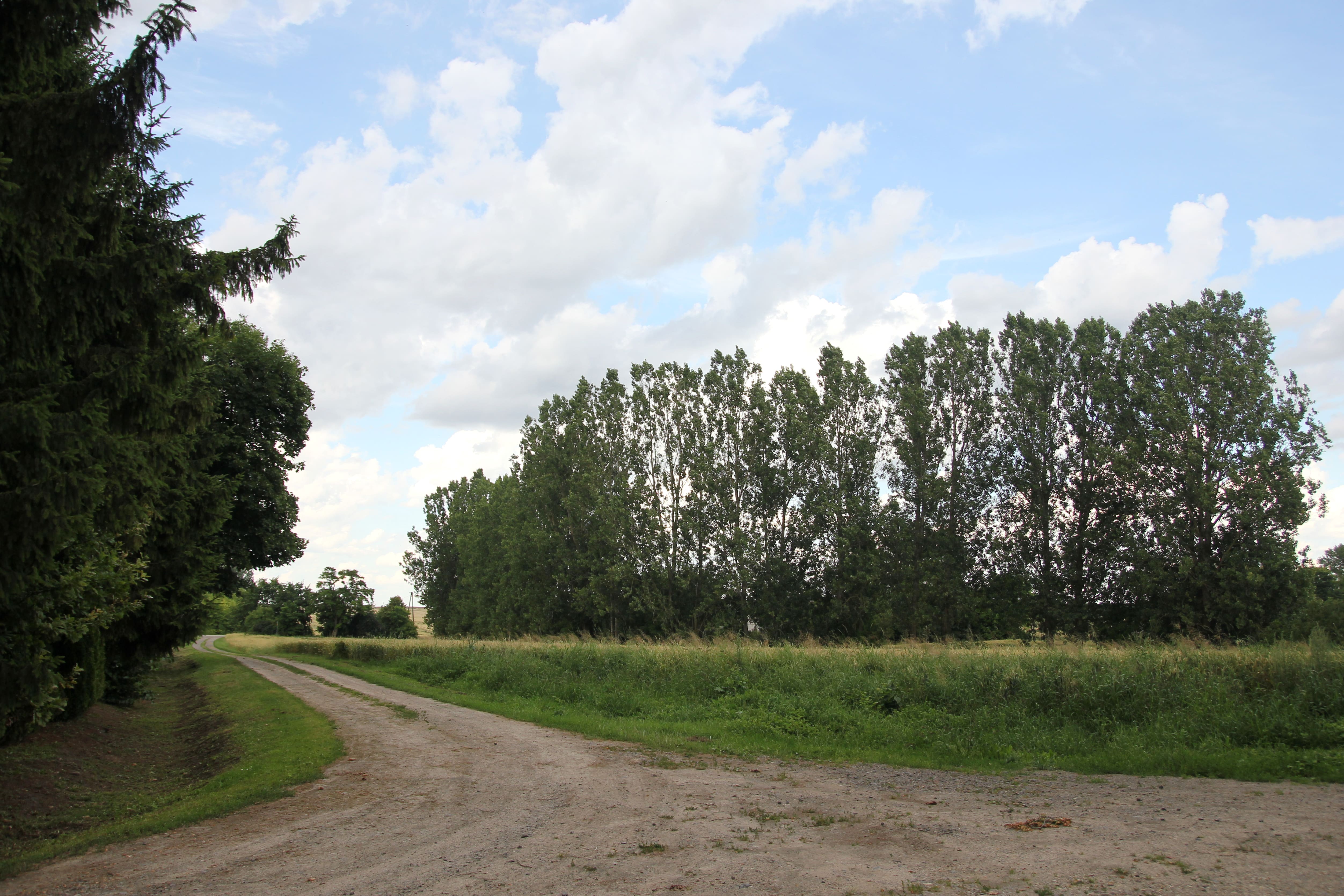
Upon entering the Zamość region, one will arrive in Sahryń, a village with a long-standing Ukrainian population, both before and during World War II. In 2008, a monument was erected there to commemorate these events. Notably, ten years later, the then-Ukrainian President Petro Poroshenko even took part in the celebrations. However, if one enters “Sahryń cemetery” into a GPS system, the system will likely direct the driver to a recently established Roman Catholic cemetery. This cemetery has no connection to the history of the massacre and is located away from the village, situated among fields and in proximity to a small forest.
On Sunday morning, two teenagers are cleaning one of the graves. They know that somewhere there is another “old cemetery,” though they don’t know much about its Ukrainian and Orthodox, as well as earlier Greek Catholic, history. Nonetheless, elements of former Eastern Christianity can be observed in the most unexpected places. For example, the local Roman Catholic parish has patrons who are quite unusual for Poland, including St. Cyril and Methodius (this is due to its history as a former Orthodox church and, prior to that, a Greek Catholic church).
The location of the sole monument to Ukrainian victims of the Polish underground is discreetly situated along a less-travelled road on the outskirts of Sahryń. The cemetery is difficult to see because its entrance is obscured by huge trees. Upon passing through the gate, the landscape takes on an even more surreal quality. The monument is immediately visible, and a bouquet of flowers in the Ukrainian national colours is present, though it is unclear whether it was placed there by the Regional Union of Ukrainians in Poland or the Ukrainian consulate in Lublin. In any case, the surroundings differ significantly from the photos of the ceremony attended by the Ukrainian former head of state, Poroshenko.
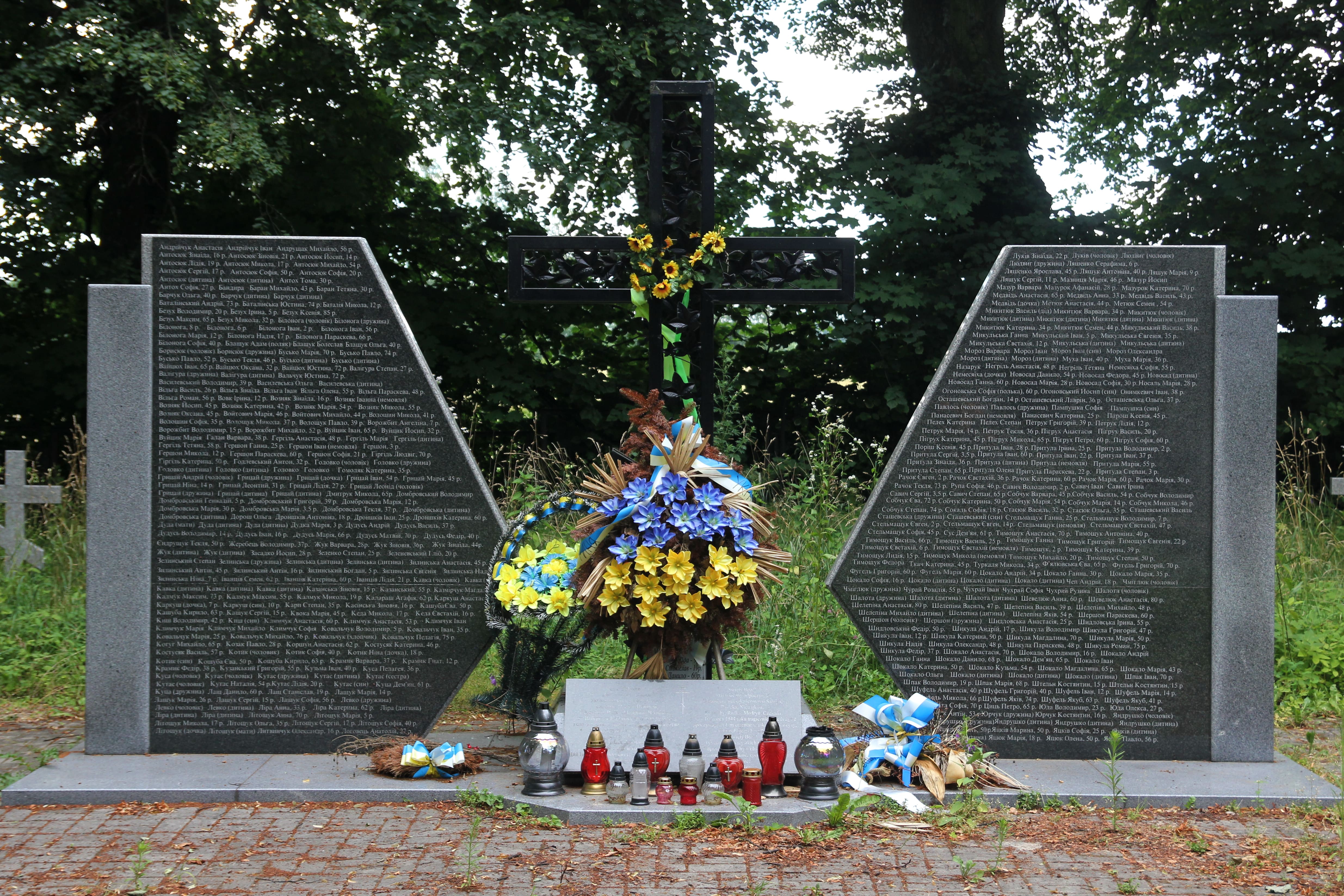
Despite its large size, the cemetery is in poor condition, with tall grass and many gravestones (the youngest of which are from the 1940s) in need of repair. The impression of unreality is further exacerbated by a glance at the condition of the graves. We have a gravestone with inscriptions in Bulgarian, a monument to a Roman Catholic priest, lots of Orthodox crosses, sometimes without names, sometimes with information about the life and activities of representatives of the local Ukrainian community. Finally, there is a gravestone (seemingly much younger than the others), which looks like an element of a posthumous historical polemic — on one side, the monument honors Ukrainians who perished in Sahryń and neighbouring villages, while on the other side, it commemorates a Polish soldier who died fighting the Red Army (although the inscription does not mention this, it does refer to death at the hands of “Ukrainian communists”).
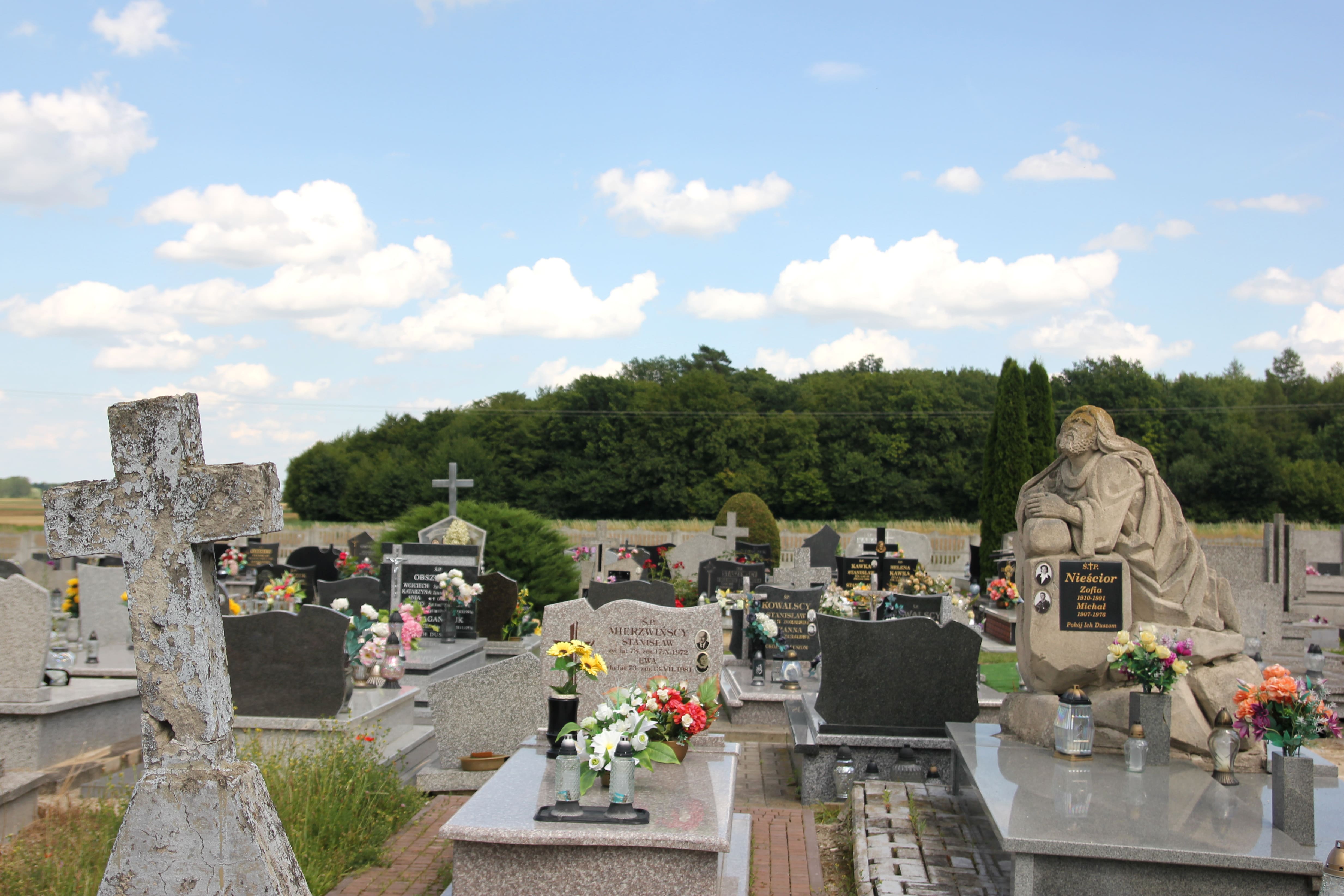
A local woman asserts that she is unaware of the reasons why the cemetery is no longer being maintained, even though she has heard about plans to renovate the grave of a Roman Catholic priest buried there. She cannot remember when the site was finally abandoned, and she emphasizes that it was “a cemetery for everyone — for Ukrainians and Poles, Orthodox Christians and Catholics.”
However she does not say much about the crime itself, which remains obscured by the intricate course of history, akin to how the cemetery itself is concealed by the imposing trees.
The Way Forward
According to John-Paul Himka, a Canadian historian specializing in Ukrainian-Polish memory politics, the shift in Polish-Ukrainian memory relations can be traced back to the mid-2000s, a period that witnessed the rise of nationalist forces to power on both sides of the border. “I would date the shift to when the Law and Justice party came to power in Poland in 2005, and in that same year Viktor Yushchenko became president of Ukraine. Each of these was an electoral victory for the nationalist right,” Himka explains.
While government narratives have certainly played a major role in shaping public opinion, Himka believes that popular memory, especially among ordinary citizens, has also been a pivotal factor. “The issue of the UPA’s massacres of the Polish population had strong roots in the memories of ordinary people in both countries,” he says. “Of course, these memories were completely divergent in Poland and Ukraine.”
We have indeed seen how divergent these memories are — and how, if left unaddressed, they risk undermining what has otherwise been a solid and strategic alliance between Poland and Ukraine. The memory of Volhynia has resurfaced through a variety of means, including exhumations, state commemorations, political instrumentalization, conspiracy narratives, and deeply rooted historical grievances. As this complex past returns to the forefront of public debate, the challenge now is to distinguish between the legitimate pursuit of historical justice and the exploitation of trauma for ideological or electoral advantage.
The European Union, for its part, could, and should, do more. It has a crucial role to play not only in mediating such tensions between current and prospective member states, but also in shaping a more coherent, forward-looking approach to shared memory politics. The Volhynia case is not an isolated incident; similar unresolved disputes affect many parts of the EU’s eastern and southeastern neighbourhoods. Brussels should take more initiative in promoting dialogue, encouraging joint historical commissions, and ensuring that memory policies do not derail democratic values or integration processes.
This historical reckoning must go both ways. While Ukraine is called upon to openly acknowledge the crimes committed by nationalist forces during World War II, Poland must also confront the darker chapters of its own history, including interwar repression and forced assimilation, as well as postwar operations such as “Wisła” and the retaliatory killing of Ukrainian civilians [editor’s note: Operation Wisła was the codename for the 1947 forced resettlement of nearly 150,000 Ukrainians from the southeastern provinces of Poland to the territories in the west of the country].
The presence of nationalist populists on both sides, who often mirror each other’s narratives, is a major obstacle. So too is the silence surrounding shared truths and unresolved pain. The way forward lies in a mutual, critical reassessment: one that avoids heroic myths and embraces complexity. Only through such efforts can Poland and Ukraine hope to turn Volhynia from a wound into a space of reconciliation and establish a foundation for a shared European future. Yet it is a way paved with obstacles, where resentment is forged and perpetuated through bronze monuments and truth is sometimes obscured by a grove of trees.
* A powiat is the secondary-level unit of local government in Poland, similar to a county, district, or prefecture in other countries.

This article was produced within the framework of PULSE, a European initiative that supports cross-border collaborative journalism.
Photos by Francesco Brusa

Мы намерены продолжать работу, но без вас нам не справиться
Ваша поддержка — это поддержка голосов против преступной войны, развязанной Россией в Украине. Это солидарность с теми, чей труд и политическая судьба нуждаются в огласке, а деятельность — в соратниках. Это выбор социальной и демократической альтернативы поверх государственных границ. И конечно, это помощь конкретным людям, которые работают над нашими материалами и нашей платформой.
Поддерживать нас не опасно. Мы следим за тем, как меняются практики передачи данных и законы, регулирующие финансовые операции. Мы полагаемся на легальные способы, которыми пользуются наши товарищи и коллеги по всему миру, включая Россию, Украину и республику Беларусь.
Мы рассчитываем на вашу поддержку!

To continue our work, we need your help!
Supporting Posle means supporting the voices against the criminal war unleashed by Russia in Ukraine. It is a way to express solidarity with people struggling against censorship, political repression, and social injustice. These activists, journalists, and writers, all those who oppose the criminal Putin’s regime, need new comrades in arms. Supporting us means opting for a social and democratic alternative beyond state borders. Naturally, it also means helping us prepare materials and maintain our online platform.
Donating to Posle is safe. We monitor changes in data transfer practices and Russian financial regulations. We use the same legal methods to transfer money as our comrades and colleagues worldwide, including Russia, Ukraine and Belarus.
We count on your support!
SUBSCRIBE
TO POSLE
Get our content first, stay in touch in case we are blocked

Еженедельная рассылка "После"
Получайте наши материалы первыми, оставайтесь на связи на случай блокировки














.svg)

